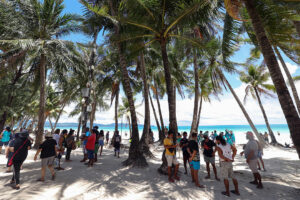PHL sees 2M visitor arrivals by yearend

THE PHILIPPINES is expected to record over two million tourist arrivals by the end of the year, putting it on track to return to pre-pandemic levels by 2024, the Tourism Congress of the Philippines (TCP) said on Monday.
TCP President Jose C. Clemente III said the group now projects around 2 to 2.1 million visitor arrivals by the end of the year, more than double their initial projections.
“This is a far cry from where we were expecting it to be. My initial projection was only 1 to 1.2 million for this year. I am happy to be wrong as far as that’s concerned,” he said in an interview with BusinessWorld Live on One News channel.
As of Oct. 7, the Philippines has logged 1.67 million tourist arrivals since reopening its border in February this year, the Department of Tourism (DoT) said.
Of the total, 1.19 million are foreign tourists while 481,109 are overseas Filipinos.
However, geopolitical tensions may delay the full recovery of the tourism industry.
“Forward bookings for 2023 are also looking quite strong, but…there’s also some geopolitical considerations to probably factor in as far as recovery is concerned. Getting back to pre-pandemic levels, (the) closest would probably be in 2024. It’s probably when we expect to be back to our 8-million level,” Mr. Clemente said.
In 2019, the Philippines recorded 8.2 million tourist arrivals, mainly from South Korea, China, the United States and Japan.
However, tourist arrivals plunged 82% to 1.5 million in 2020 due to the strict lockdown and border restrictions amid the coronavirus disease 2019 (COVID-19) pandemic. This downward trend continued in 2021 as the country received only 163,879 foreign visitors.
Mr. Clemente said the Philippines is hoping to attract Japanese tourists once again.
In 2019, Japan was the fourth-biggest source of foreign tourist arrivals, with 682,788 visiting the Philippines.
“The market that we are also looking at is Japan…We’re probably looking at towards the end of the year or towards the first quarter of next year for the Japan market to start coming in, so that should help boost our visitor arrivals,” Mr. Clemente said.
While the industry is currently seeing a spike in demand due to “revenge travel,” he warned that a looming global recession may hurt recovery momentum.
“The one thing we’re really more cautious about is the possibility of a global recession. I’m more afraid of it now than COVID-19 actually. That might stunt the growth of arrivals we’ve had,” Mr. Clemente said.
“The global recession, if and when it happens, will definitely play a role as far as travel patterns are concerned. People will opt to go to closer places (and) may not travel as far as they used to. But we’re keeping our fingers crossed as far as this is concerned,” he added.
The current weakness of the peso against the US dollar is good for the travel industry, he noted.
“One of the good effects of the devaluation of the peso is that our travel or tourism products are actually cheaper because the tourism industry is like an exporter. If we can manage to keep our prices down, that might be a way of mitigating the effects of the global recession,” Mr. Clemente said.
The peso closed at P59 against the US dollar on Monday, down 6.5 centavos compared with its P58.935 finish on Friday last week, according to the Bankers Association of the Philippines. The local unit has declined by 15.68% or P8 from its P51 close on Dec. 31 last year. — Revin Mikhael D. Ochave




